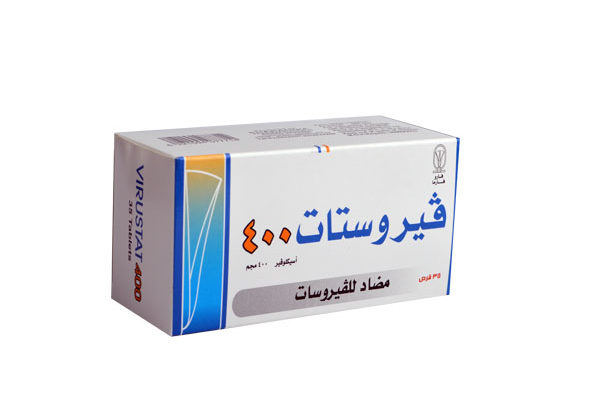فيروستات - دواء مضاد للفيروسات
فيروستات هو دواء مضاد للفيروسات يُستخدم بشكل أساسي لعلاج العدوى الناتجة عن فيروسات الهربس. يساعد في تخفيف الأعراض وتقليل شدة النوبات لكنه لا يُعالج الهربس بشكل كامل.
أشكال الدواء
- أقراص: متوفرة بتركيزات 200 ملغ، 400 ملغ، و800 ملغ.
- محلول فموي: يحتوي 5 مل على 200 ملغ من الأسيكلوفير.
المكونات الفعالة
- أسيكلوفير
المكونات غير الفعالة
- الأقراص: تختلف حسب التركيز، وتشمل اللاكتوز الأحادي المائي، نشا الذرة، كروسكارميلوز الصوديوم، ثاني أكسيد السيليكون الغروي، بوفيدون، سترات المغنيسيوم، والألوان (إريثروسين لايك وكوينولين أصفر).
- المحلول الفموي: سليلوز متفرق، كرميلوز الصوديوم، سوربيتول، ميثيل بارابين، بروبيل بارابين، نكهة الفانيليا، سترات الصوديوم، حمض الستريك، ماء نقي.
المؤشرات العلاجية
- الهربس زوستر: لعلاج الحاد للجديري المائي.
- الهربس التناسلي: لعلاج النوبات الأولية والنوبات المتكررة.
- الجديري المائي: لعلاج الحمى.
الجرعة وطريقة الإعطاء
البالغين:
- الهربس البسيط: 200 ملغ خمس مرات يوميًا لمدة 5 أيام.
- الوقاية: 200 ملغ أربع مرات يوميًا؛ يمكن تعديل الجرعة إلى 400 ملغ مرتين يوميًا.
- الوقاية في المرضى المناعيين: 200 ملغ أربع مرات يوميًا.
- الجديري المائي والهربس زوستر: 800 ملغ خمس مرات يوميًا لمدة 7 أيام.
- المرضى المناعيين بشدة: 800 ملغ أربع مرات يوميًا.
الأطفال:
- الهربس البسيط والوقاية: الجرعات المخصصة للبالغين للأطفال فوق سن عامين.
- الجديري المائي: 800 ملغ أربع مرات يوميًا للأطفال فوق 6 سنوات؛ 400 ملغ أربع مرات يوميًا للأطفال بين 2 و6 سنوات.
كبار السن: قد تحتاج الجرعات إلى تعديل بسبب انخفاض وظائف الكلى.
موانع الاستعمال
- فرط الحساسية المعروف للأسيكلوفير أو الفالاسيكلوفير.
التحذيرات والاحتياطات
- فشل الكلى، متلازمة التجلط الدموية والتخثر، تم الإبلاغ عنها في المرضى المناعيين.
- لا يُوصى به للأطفال تحت سن عامين.
- تعديل الجرعة ضروري في حالات ضعف وظائف الكلى.
- يجب الحفاظ على الترطيب الكافي أثناء العلاج.
التفاعلات الدوائية
- تفاعلات محتملة مع بروبينسيد وسيميتيدين، التي قد تزيد من مستويات الأسيكلوفير في البلازما.
استخدامه أثناء الحمل والرضاعة
- الحمل: لا زيادة في معدل العيوب الخلقية، ولكن يُوصى بالحذر.
- الرضاعة: الأسيكلوفير موجود في حليب الثدي؛ يُوصى بالحذر.
الآثار الجانبية
- عام: ردود فعل تحسسية، حمى، صداع.
- الجهاز العصبي: ارتباك، هلاوس، نوبات.
- الجهاز الهضمي: غثيان، إسهال.
- الجهاز البولي: فشل الكلى، زيادة في اليوريا في الدم.
الجرعة الزائدة
- الأعراض تشمل الغثيان، الارتباك، وفشل الكلى. يمكن أن يساعد الغسيل الكلوي في إزالة الأسيكلوفير من الدم.
التعبئة
- أقراص 200 ملغ: عبوة تحتوي على 20 أو 100 قرص.
- أقراص 400 ملغ: عبوة تحتوي على 7 أو 100 قرص.
- أقراص 800 ملغ: عبوة تحتوي على 35 قرص.
- محلول فموي: زجاجة 120 مل.
التخزين
- يحفظ في درجة حرارة لا تتجاوز 30°C. يُحفظ بعيدًا عن متناول الأطفال.
تم إنتاجه بواسطة فاروفارما (الفرعونية) للأدوية في مدينة برج العرب الجديدة، الإسكندرية.
عن الكاتب
الدكتور أحمد باكر، دكتور صيدلة
هو صيدلي أول ومثقف صحي يتمتع بخبرة واسعة في منطقة الشرق الأوسط وشمال أفريقيا. يهدف الدكتور أحمد من خلال كتاباته إلى تمكين المجتمعات من خلال توفير معلومات صحية موثوقة تستند إلى الأدلة العلمية. بفضل خبرته في الصيدلة السريرية والشؤون التنظيمية، يسعى لتقديم رؤى فريدة حول الرعاية الصحية وتبسيط المفاهيم الطبية المعقدة لجعلها في متناول الجميع.
إخلاء المسؤولية القانونية
المعلومات المقدمة في هذه المدونة هي لأغراض تعليمية فقط ولا تعتبر بديلاً عن المشورة الطبية المتخصصة. لا نضمن دقة أو اكتمال المعلومات المتعلقة بالأدوية أو المستحضرات الطبية، ويجب التحقق من المصادر الرسمية قبل اتخاذ أي قرارات. باستخدام هذه المدونة، فإنك توافق على تحمل المسؤولية الشخصية عن الاعتماد على المعلومات المقدمة.


تعليقات
إرسال تعليق